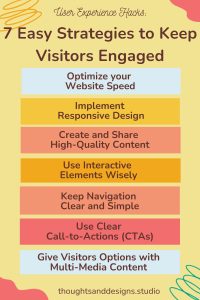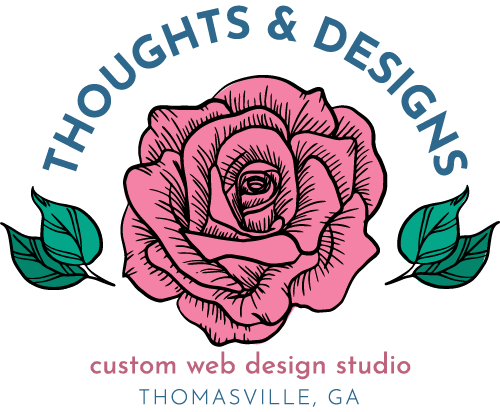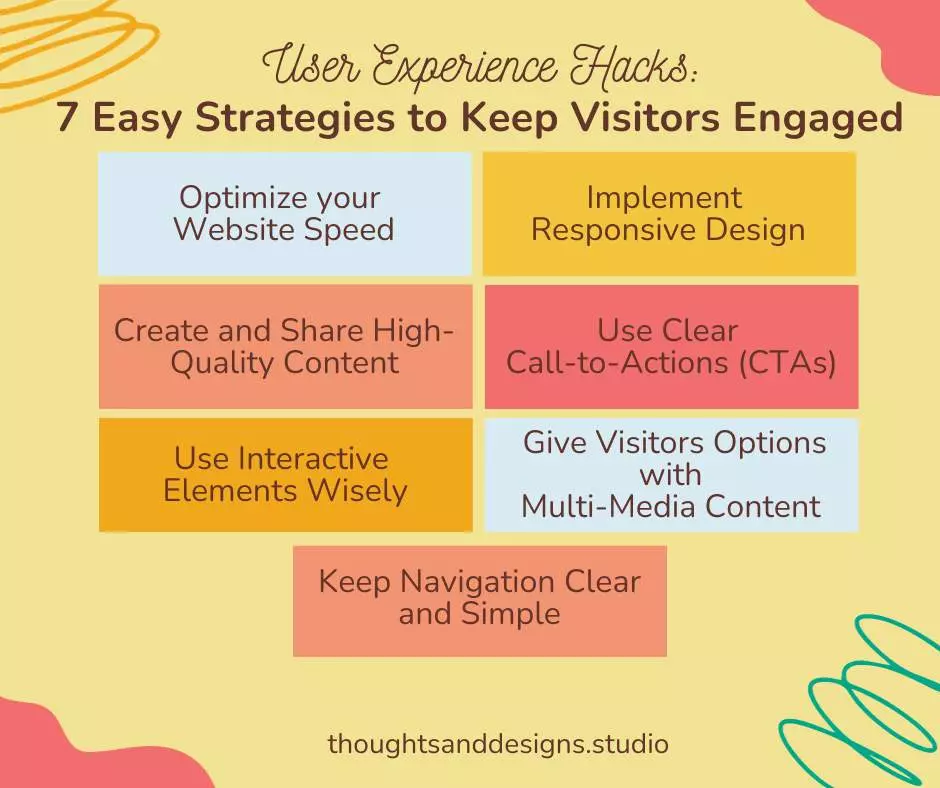In the digital age, user experience (leading to higher user engagement) is paramount to the success of your website.
When you give your visitors a great user experience, they are going to want to stay, rather than flee, your website. And a great user experience leads to improved user engagement.
This means, you’ll have visitors taking action on your website, rather than just arriving and leaving.
The more engaged your visitors are, the longer they’ll stay, the more they’ll explore, and the more likely they are to convert into loyal customers.
Here are seven quick and easy ways to boost user engagement on your website through better user experience.

1. Optimize Website Speed for better user experience
Slow-loading websites can drive users away.
Use tools like Google PageSpeed Insights or GT Metrix to identify and fix performance issues.
- Compress images in an image editor like Photoshop or by using a plugin to ensure your image files are no bigger than 200KB
- Leverage browser caching and use a page cache plugin on your site
- Consider a content delivery network (CDN) for faster loading times (such as Cloudflare.com)
- Don’t bog down your pages with excessive videos, animations, and other decorations
2. Implement Responsive Design
Most people surf the web from their phones. How does your site look on a small screen?
Ensure your website is responsive, adapting seamlessly to various screen sizes and devices. Mobile users should have the same positive user experience as desktop users.
3. High-Quality Content
Create valuable, informative, and engaging content.
This includes:
- Well-researched articles
- Informative videos
- Engaging infographics
- Attractive, relevant images
These can captivate your audience, providing a great user experience, and keep them coming back for more.
4. Clear Call-to-Actions (CTAs)
Use clear and enticing CTAs strategically placed throughout your website. Guide visitors on what actions to take, such as
- Signing up for a newsletter
- Making a purchase
- Filling out a form for more information
- Sharing content on social media
- Checking out a related post or resource
A CTA doesn’t have to be a spammy, high pressure sales tactic. It can simply be you pointing out to your customers what you recommend they do next. If this is their first time on your website, they may not realize all of the great, related content and resources (both free and paid) you are offering.
In other words, think of it as helping them find the goods for a better user experience.
5. Interactive Elements
Interactive elements are a double edged sword. On the one hand, they can increase user engagement and provide an entertaining user experience if they are done well.
If not done well, they are annoying, slow down the website, and waste everyone’s time.
Sure, a quiz may convert more people to be newsletter subscribers, but are you getting the kind of subscribers who want to read what you’re saying, or are you just getting people who want to find out what kind of potato they are?
Incorporating interactive features like
- Quizzes
- Polls
- Surveys
- Social Sharing Buttons
These features can encourage user participation and lower your bounce rate. But only do it with a strategy in mind that ties into your website (and business) purpose.
Website Forms and User Experience
Forms, used for your visitors to contact you, should also be optimized for a great user experience. They aren’t quite as fun as quizzes, but they are more important.
Improve the user experience on your forms by not asking for too much unnecessary information. The more information you’re asking for, the less likely someone is to fill out a form. For example, many people (myself included) are hesitant to fill out a form that asks for a phone number. If I wanted a phone call I’d have called you. Keep your forms simple and only ask for the important stuff.
6. Multi-Media Content
By providing content in a variety of formats, you’re giving your users options for how to consume what you’re offering. Just a few caveats:
- Don’t over do it. No more than one video or audio on a page so it still lows quickly.
- Never set up videos or audio to auto play. That’s annoying and no one likes that.
- Make sure you embed video and audio with all of the controllers working. Most websites (such as WordPress) do this automatically now.
As I mentioned in a post about website accessibility, giving your visitors options is always a good thing, and helps to improve both website accessibility and user experience.
7. Clear and Simple Navigation
Navigation is a great way to improve user experience. When the menus for a website are made simple, clear, and direct, it’s easier for your visitors to find their way around your website.
You do not have to put every page of your website in your navigation menu. In fact, you shouldn’t do that.
When a visitor has too many choices, they often feel overwhelmed and leave.
In other words, instead of showing them where to find everything, they wind up getting frustrated and leaving.
By implementing these quick and easy strategies, you can enhance user user experience and increase user engagement on your website and create a positive, interactive experience that keeps your audience coming back for more.
An improved user experience leads to a more engaged audience, which can lead to increased conversions and a stronger online presence.



